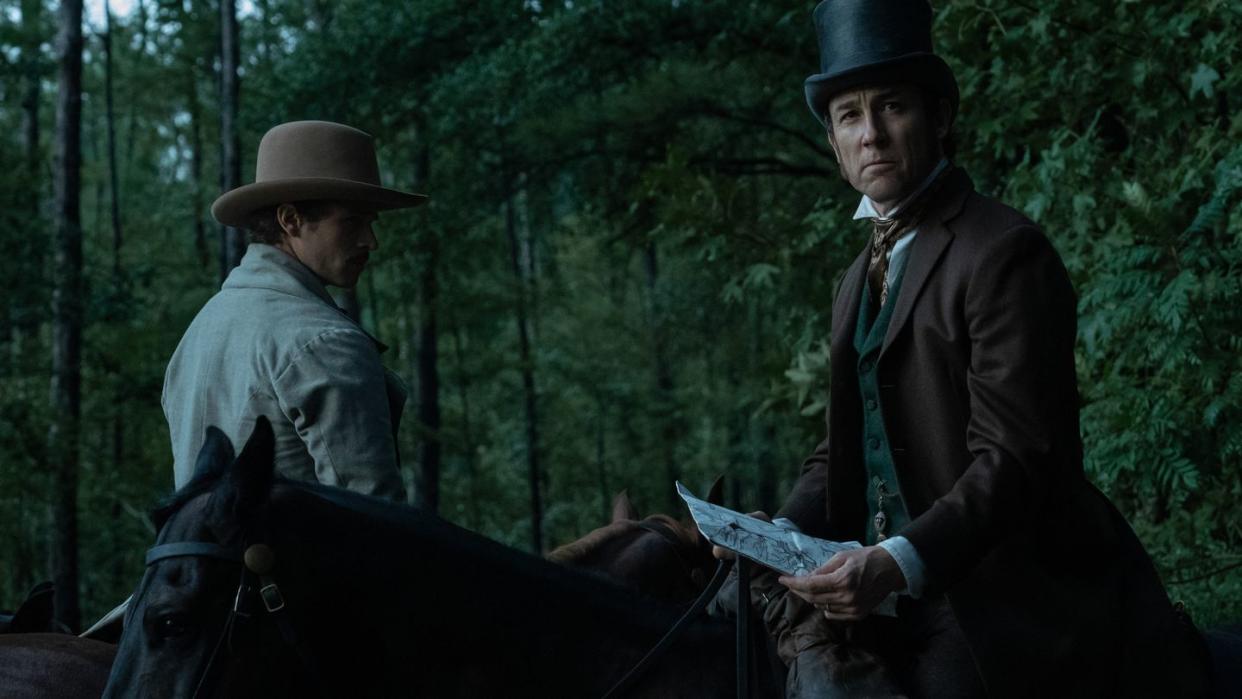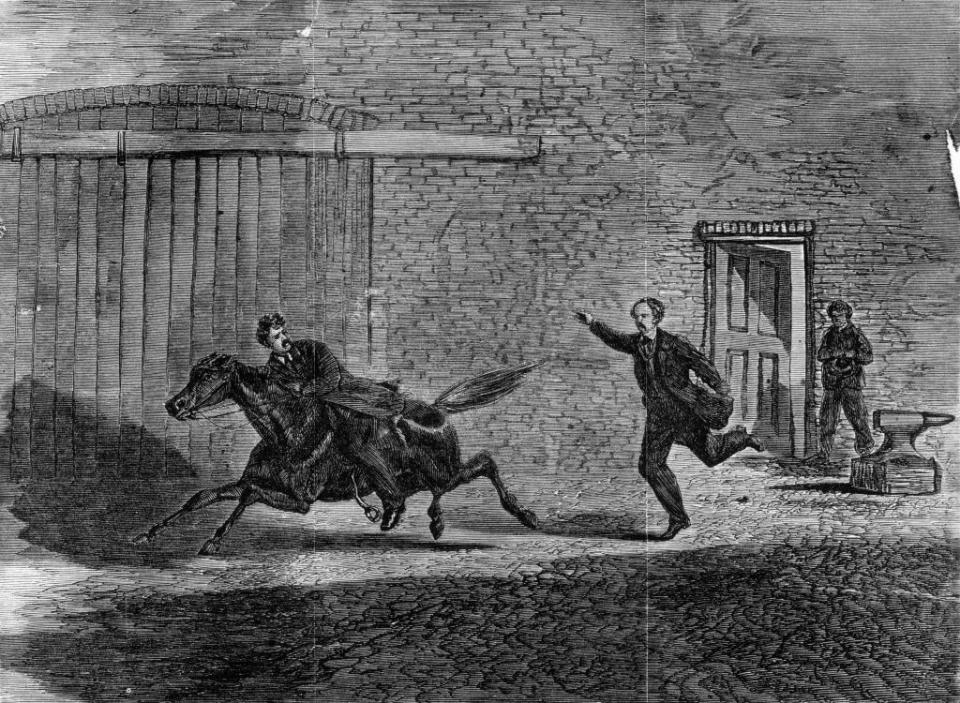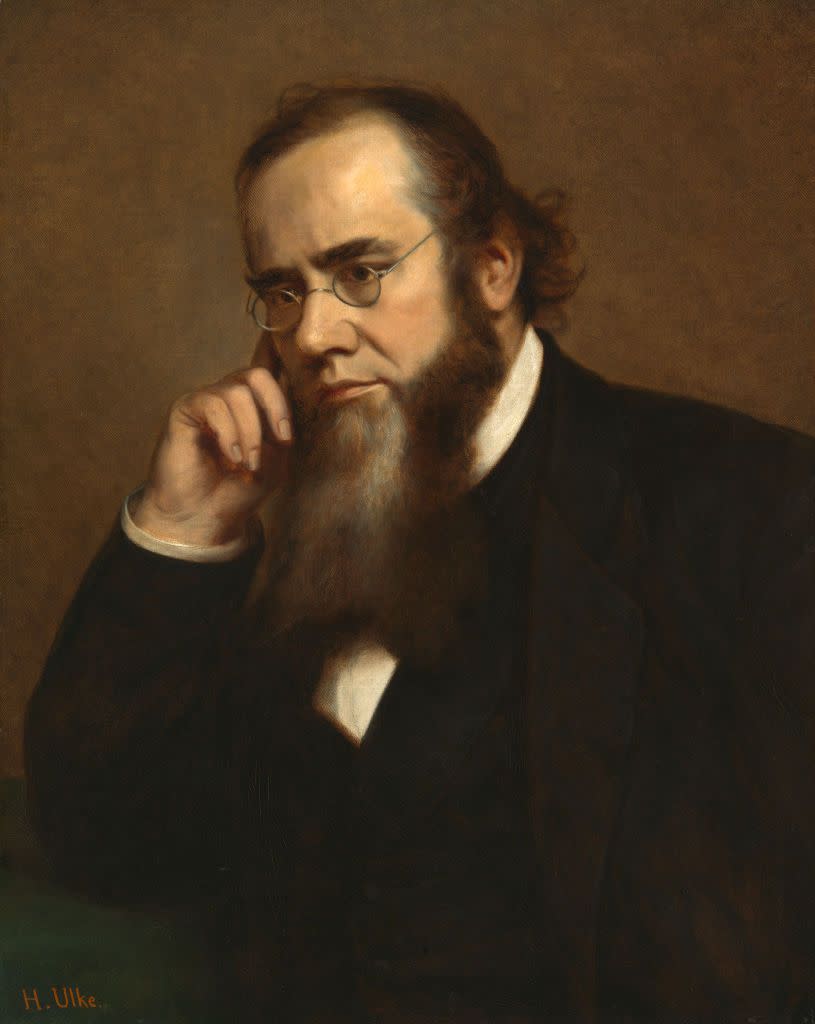The True Story of ‘Manhunt’ and One Man’s Obsessive Quest to Capture John Wilkes Booth

"Hearst Magazines and Yahoo may earn commission or revenue on some items through these links."
Even after almost 160 years of exhaustive study and analysis, the death of President Abraham Lincoln continues to intrigue scholars and history buffs eager to understand what really happened. Enter Manhunt, an new Apple TV+ miniseries that shifts the perspective to the eyes of Lincoln’s assassin, John Wilkes Booth, and the government official who led the effort to catch him.
The first two episodes of the seven-part drama, based on James Swanson’s nonfiction book Manhunt: The 12-Day Chase for Lincoln’s Killer, premiere Friday on the streaming service. Anthony Boyle stars as Booth and Tobias Menzies portrays Edwin Stanton, the U.S. secretary of war who vehemently pursued the assassin and vowed to enact justice.
Booth and his history-altering act at Ford’s Theatre on April 14, 1865, are well known, but the aftermath of the shooting and its wide-reaching implications have long been the subject of speculation and conspiracy. Here’s a closer look at the actual search that inspired Manhunt.
Booth was a very public figure
John Wilkes Booth didn’t have the benefit of anonymity in anything he did, let alone committing a very public crime. Born near Bel Air, Maryland, on May 10, 1838, Booth was the son of popular stage actor Junius Brutus Booth. Naturally, John and his brother Edwin followed in their father’s footsteps and became performers themselves.
John debuted at age 17 in a production of William Shakespeare’s Richard III and performed so well that an acting company based in Richmond, Virginia, asked him to go on tour. Within a few years, he was a nationally-known figure and something of a heartthrob. “The ladies loved him; he was very popular,” said Clark Evans, a curator for the Library of Congress.
But as his fame grew, so did his discontent with the government. According to the University of Missouri-Kansas City, Booth became an agent for the Confederacy during the Civil War, often meeting with the heads of its secret service. He and Southern sympathizers began forming a plot to kidnap Lincoln, hoping to use him as ransom to negotiate the release of Confederate prisoners of war.
But once Confederate General Robert E. Lee surrendered on April 9, 1865—making it clear the war was nearing an end—kidnapping Lincoln would no longer serve any purpose. Still, when Booth knew the president would be attending a performance of Our American Cousin five days later in Washington, D.C., he vowed to go a step further.
His escape wasn’t subtle, either

Booth, who was very familiar with the layout of Ford’s Theatre, made his way into the box occupied by the president and First Lady Mary Todd Lincoln at around 10:15 p.m. After shooting Lincoln with his Deringer pistol, which he subsequently dropped, and fighting off intervening military officer Henry Rathbone with a dagger, Booth fell from the box onto the stage.
According to witnesses, he yelled, “Sic semper tyrannis!” The Virginia state motto to this day, the Latin phrase translates to “Thus always to tyrants!” He was chased out the back of the theater by a man named Joseph B. Stewart and ultimately fled on horseback.
According to the National Park Service, Lincoln’s unconscious body was brought to the first-floor bedroom of a neighboring house. He died at 7:22 a.m. on April 15. In the meantime, Stanton had already begun his investigation and eyewitness interviews. The manhunt was on.
Booth received plenty of help
Although Booth has, understandably, garnered most of the infamy from Lincoln’s murder, he didn’t act alone. Officials questioned hundreds of people in the days following the shooting and determined 9 other individuals had a significant role in the plot also meant to kill then-Vice President Andrew Johnson and Secretary of State William Seward.
The conspirators included David Herold (played in Manhunt by Will Harrison), as well as boarding house owner Mary Surratt (Carrie Lazar) and her son John (Joshua Mikel). Each offered direct aid to the fugitive Booth, who quickly crossed into Maryland on his path south where he’d likely find more sympathizers for his cause.
Booth and Herold stopped for guns and supplies at the Surratt family tavern, and the two next made their way to the home of physician Samuel Mudd (Matt Walsh), who later claimed he was unaware of what they had done. The doctor made a splint for Booth’s broken leg early on the morning of April 15 and offered the two men shelter.
How Booth fractured his leg is still a mystery. It was initially believed he suffered the injury during his tumble to the Ford’s Theatre stage, and Booth even wrote in his diary that he “in jumping broke my leg.” However, some historians now think it’s much more likely his fast-galloping horse tripped during the escape and landed on his left leg.
Booth and Herold continued on toward the Potomac River, hiding in a pine thicket for days until it was safe to cross into neighboring Virginia. They finally made it on April 22, but their escape would last only a couple more days.
Stanton and investigators quickly pursued Booth

By this point, the search for Booth, Herold, and John Surratt was well underway. Within 24 hours of the shooting, Secret Service director Lafayette Baker (Patton Oswalt) had obtained photographs of the three men that were then featured on a wanted poster Stanton and the War Department published. Additionally, a lockdown was enacted, with guards stationed around all forts and most people prohibited from entering or leaving the nation’s capital.
The notion that Booth and his conspirators would have any chance of acquittal via trial was quickly rendered absurd. Officially published on April 20, 1865, the War Department’s wanted poster offered a total reward of $100,000 (equivalent to nearly $2 million today) for the apprehensions of Booth, Surratt, and Herold. Stanton didn’t mince words about the three figures on the poster; he presumed guilt for not just Booth, whom he referred to as “the murderer of our late beloved president,” but the two accomplices as well. The poster continued:
“Let the stain of innocent blood be removed from the land by the arrest and punishment of the murderers. All good citizens are exhorted to aid public justice on this occasion. Every man should consider his own conscience charged with this solemn duty, and rest neither night nor day until it be accomplished.”
According to the U.S. Army Center of Military History, thousands of civilians and military personnel searched for the outlaws under Stanton’s direction. Eventually, troops cornered Booth and Herold inside a barn on the Virginia farm of Richard Garrett in the early hours of April 26. Herold immediately surrendered, but Booth refused and was shot by Sergeant Boston Corbett in the ensuing standoff. He died a couple hours later.
As for the remaining seven conspirators, all except John Surratt who had fled the country were quickly apprehended and tried by military tribunal. Four were hanged, including Mary Surratt, who became the first woman executed by the federal government later that July.
Conspiracy theories persisted for more than a century
Not surprisingly, the public’s fascination with the fate of Booth and his conspirators began almost immediately. The New Yorker writes that later in 1865, a New York World reporter named George Alfred Townsend published a 79-page account of his investigation into Lincoln’s assassination, complete with maps, floor plans, and witness testimony.
Still, speculation became rampant. According to The New Yorker, many in Lincoln’s administration believed Confederate President Jefferson Davis ordered the assassination. After this idea waned, it was suggested that Vice President Johnson—or even Stanton and Baker—might have been behind the plot for political reasons.
Much more recently, David Balsiger and Charles Sellier Jr.’s 1977 book The Lincoln Conspiracy and the subsequent movie adaptation posited their own alternative and inaccurate theory about what happened. On the basis of newly uncovered evidence such as missing diary entries from Booth, the book alleged that Booth survived the manhunt and fled overseas to England. The authors also claimed that instead of killing the murderer, troops fatally shot a Booth lookalike named J.W. Boyd by mistake, and the government hid the error as part of a cover-up. But obituaries and family papers showed that Boyd didn’t die at Garrett’s barn and instead passed away months later in January 1866.
Thomas Turner, a Bridgewater State University professor who published several articles about the assassination, wrote in 1982 that the attention around Lincoln’s death and the manhunt for Booth follows a pattern typical to that of other beloved hero-villain folk tales. “In traditional mythology, the slayer [Booth] of the folk god [Lincoln] cannot be released by an ordinary death but must wander the world alone and branded with infamy,” Turner explained. “The murderer owes everything to the deification of his victim. No one has ever read or questioned where the murderers of Presidents Garfield and McKinley are buried, but the murderer of Lincoln could not rest so easy.”
Watch Manhunt on Apple TV+ Now
The two-part premiere of Manhunt is Friday, March 15, on Apple TV+. New episodes release weekly on Fridays through April 19. The limited series stars Tobias Menzies as Edwin Stanton, Anthony Boyle as John Wilkes Booth, and Hamish Linklater as President Abraham Lincoln.
Booth and Stanton are naturally bound to have a lot of screen time in Manhunt, but showrunner and executive producer Monica Beletsky promises the show will cast a wider net and incorporate overlooked figures of the war and its aftermath.
“One of the things that’s special about the show is that when we think of the Civil War, many people don’t realize how many people’s lives were touched by it, and that it was really a diverse set of people,” Beletsky told PhillyVoice.com. “I’m really excited about showing some of the unsung heroes in the story. Many who are African American, who we don’t learn about in school, and so I feel proud to tell their stories as well.”
You Might Also Like

